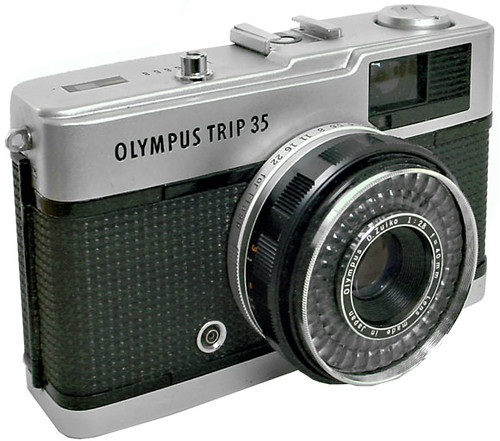The Trip 35 is a fully-automatic 35mm compact camera, manufactured by Olympus from 1967 to 1984, during which time over 10,000,000 units were sold. The auto-exposure mechanism is effectively solar-powered by a selenium cell surrounding the lens, and consequently the camera runs entirely without batteries. Until June 1978, the shutter button was silver-coloured metal. After that date, all Trips had a black plastic button.
Specifications
- Viewfinder: Standard Albada, with parallax marks. Red indication for too little light. Trick peephole to see exposure and focus settings as set on lens. The ridged window to the right of the finder window is fake, mimicking a rangefinder.
- Focus: Manual by scale, visible through viewfinder. Top scale, visible through finder, shows icons or headshot (1m/3'), twoshot (1.5m/5'), group shot (3m/10') and infinity. Bottom scale calibrated in meters and feet.
- Lens : 40mm f/2.8 Olympus D. Zuiko, 4 elements, three groups. Appears to be a front-element focusing Tessar.
- Close Focus : 2.9" (0.9m)
- Diaphragm : Two bladed, diamond-shaped, stopping down to about f/22
- Shutter : 1/40 or 1/200, automatically selected. No bulb setting.
- Cable Release : Standard socket in shutter release button
- Meter : Selenium cell around lens (automatically incorporates any filter factors)
- Exposure : Program automatic (A) and fixed-aperture for flash. (Note: if you chose a large aperture for flash and work in bright light, it stops down accordingly but keeps the shutter speed at 1/40.)
- Exposure Range : EV 8-1/3 (1/40 at f/2.8) to EV 17-1/6 (1/200 at f/27)
- Film Speed : Third stops from ASA 25 - 400, except ASA 32
- Filter Size : 43.5mm screw in
- Low Light Warning : If exposure would go below 1/40 at f/2.8, the shutter locks and a red transparent flag rises from the bottom of the finder in A setting. If this happens, use flash
- Flash : Hot-shoe and PC terminal
- Battery : None

